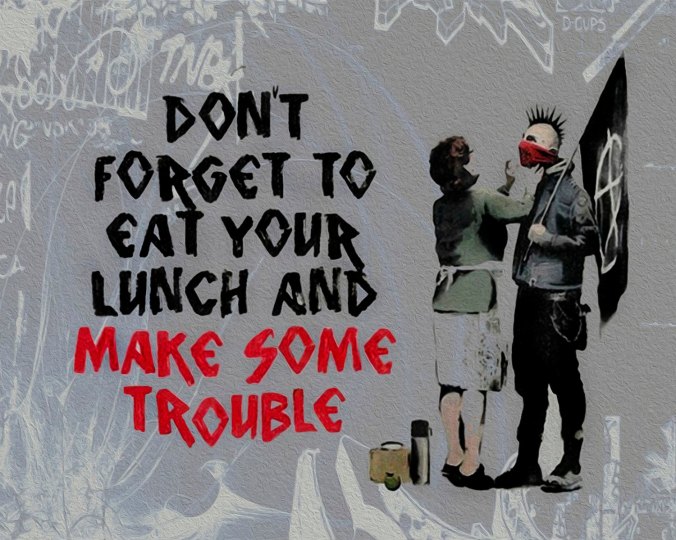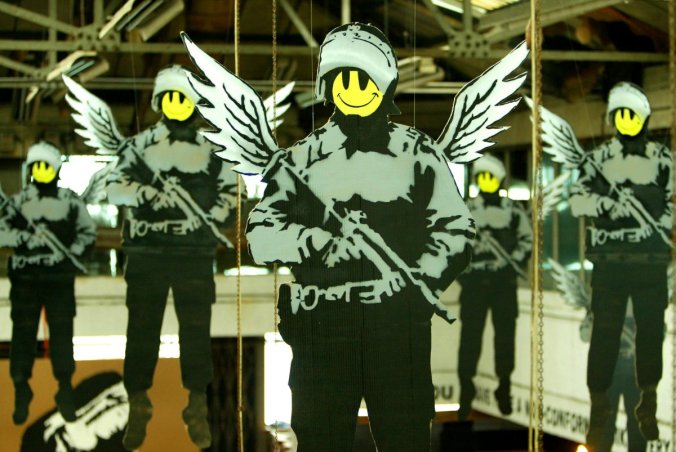My year 10 students are studying texts as vehicles of protest and I’m trying to expose them to a wide variety of visual, written and aural works but we’ve hit a wall. This isn’t a bad thing because Banksy has hit the same wall and we’re finding his art to be rich media for discussion. We’ve unpacked pictures of stuffed animals being transported to their eventual slaughter, lovers fixated with their mobile phones, kissing coppers, children interacting with or acting as soldiers, people (including Jesus) reluctant to let go of their shopping, heart-shaped balloons, bouquets of flowers, and a number of other powerful protests that critique aspects of our political, social, and economic zeitgeist.
Currently I’m asking them to write Short Answer Responses – a bizarre new text type that has been born out of a perceived need to have students analyse more without increasing the marking load of teachers and examiners. Each of the samples I’m providing below are individual pieces, so ignore the fact that I’ve rehashed the same topic sentence/thesis statement across all three. Next week I’m going to show them how, with a little bit of tweaking, we can turn these responses into a comprehensive 5 paragraph essay.
Why am I sharing this here? In studying/teaching Banksy’s art I have come to really appreciate the technique, aesthetic and depth of his work. Why wouldn’t I share this with that in mind? So, here you go. Below are three pieces and the sample responses I’ve written as exemplars for my students to follow.
Happy reading!

The provided image is of a stencilled piece of artwork by political activist and graffiti artist, Banksy. It can be read as a political protest that encourages anarchism through its symbolism, composition and epigram. The salient part of the image is the familial relationship depicted on the right hand side. Here we see a young man in stereotypical punk garb being doted on by his mother, a conventional housewife. The man’s costuming includes a Mohawk styled as liberty spikes. This particular hair style alludes to the Statue of Liberty which is a famous symbol of freedom and acceptance suggesting these are the ideals the man is fighting for. Furthermore, the pole for the anarchist flag he carries points at the lunch his mother has prepared for him (which consists of a flask, bag and green apple). It is a lunch one might take to work and it is this connotation, and the symbolism of the apple, that suggests rebellion is not only natural but is our responsibility. Reinforcing this is the epigram on the left hand side. The black and red colour scheme connects the young man to this message and is used to signify both power and danger. These words belong to the mother and express her maternal instincts with the instruction to “Eat Your Lunch” as well as the encouragement to “Make Some Trouble” in his fight for his rights and freedom. Most prominent in this text is the message to rebel as the bright red stands out against the dull colours and provides a connection with the man’s bandana. This, then, guides the viewers’ gaze back to the mother who straightens this mask the way she might fix a tie, thus reinforcing the theme of the image – that it is our responsibility to stand up against governmental oppression.

The provided image is of a stencilled piece of artwork by political activist and graffiti artist, Banksy. It can be read as a political protest that encourages passers-by to question the nature of surveillance through its composition, epigram and symbolism. People walking along the footpath might first notice the policeman and his canine companion who are at street level, they will then follow their gaze (and the angle of the dog’s body) which point to the large white writing and the child ‘painting’ it. This message written here states “ONE NATION UNDER CCTV” which is an allusion to the Pledge of Allegiance but with references to God replaced with CCTV. One reading of this is that people used to modify their own behaviours because they were trying to please an omnipotent deity but now they do so because they fear that they are being watched by a government that uses surveillance cameras to monitor their every move. This is reinforced with the stencilled policeman holding a camera and the strategic placement of this graffiti next to a surveillance camera. Furthermore, despite his apparent criminal activity, the child in the image maintains their innocence. This is, in part, because they are youthful (young age being synonymous with innocence and naivety) but also by interpreting their red hoodie as an intertextual nod to Red Riding Hood – a tale that includes a naïve child stalked by a murderous wolf. This, then, puts the government in the position of the antagonist. By combining these elements, audiences can determine that Banksy’s artwork is an homage to the themes in George Orwell’s 1984 and, as such, is critical of the government’s access to information about its citizens.

The provided image is a photograph of a gallery piece by political activist and graffiti artist, Banksy. It can be read as a political protest that uses symbolism, juxtaposition and irony to warn viewers of governmental oppression. Foregrounded in this image is a figure in riot gear hanging from the rafters of a building with an indeterminable number of similar figures hanging around them. The costuming immediately identifies these characters as representative of law and order with the dull colours and assault rifle connoting blind uniformity and violence. This is juxtaposed against the bright colours of the angel wings and smiley faces that have been superimposed onto the stencilled figures. Both of these additions signify ‘goodness’ through the associations developed from their use in popular culture and social media. One reading of this piece, then, is that police and armed forces do God’s work for the benefit of society. However, as Banksy is known to criticize the government and law enforcement in his other works this depiction is most likely satirical. The more cartoony elements are then presumed to be used ironically, and therefore assume greater importance in producing meaning. This is reinforced through the vectors in the composition as the butt of the gun points to the wings and the curve of these wings, as well as the figures’ shoulders, point to the smiley faces. An alternate reading, then, regards these smiley faces in a similar vein to how it has been subverted in Punk music iconography and the comic, Watchmen, where it is worn by a corrupt and violent superhero. As such, it can be assumed that Banksy has used symbolism, juxtaposition and irony in this piece to suggest that police and other authority figures hide their corruption and oppression behind a facade of wholesomeness and protection.